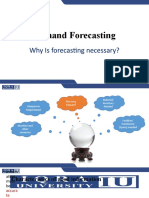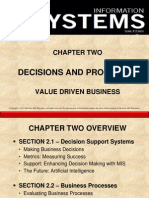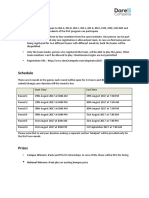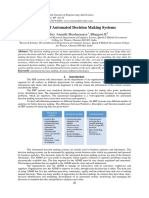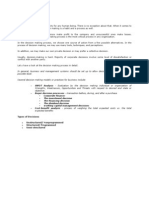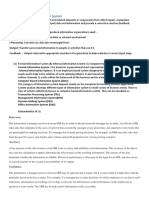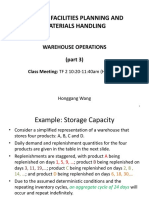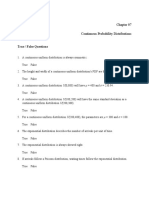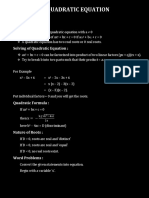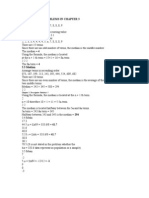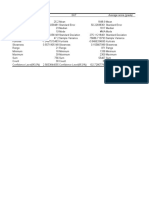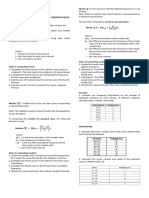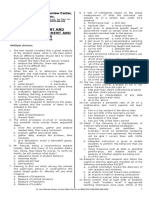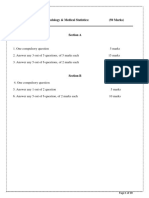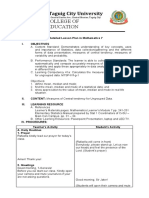Copyright© Cesim India Pvt Ltd
Decision-making guide
Ordering
Table of Contents
1. Simulation platform introduction ............................................................................... 2
1.1 Game Arena ....................................................................................................................... 2
1.2 Readings............................................................................................................................. 2
1.3 Forum ................................................................................................................................ 3
1.4 Main Objective & Winning Criteria ...................................................................................... 4
1.5 Successful decision-making flow.......................................................................................... 4
2. Game Arena .............................................................................................................. 5
2.1 Introduction ....................................................................................................................... 5
2.2 Food for Thought ................................................................................................................ 5
2.3 Market ............................................................................................................................... 6
2.4 Phase 1............................................................................................................................... 6
2.5 Phase 2............................................................................................................................... 9
2.6 Decision checklist ............................................................................................................. 10
2.7 Report .............................................................................................................................. 11
2.8 Synopsis ........................................................................................................................... 13
� Copyright© Cesim India Pvt Ltd
1. Simulation platform introduction
1.1 Game Arena
The gaming arena interface comprises various decision tabs that includes market, decision
phases, the Decision checklist, Report, and Synopsis. Some sections must be completed first
as they have an impact on other areas.
Figure 1 Game Arena
1.2 Readings
This section provides essential materials necessary for participants to actively engage in the
game. The main reading material consists of a guide for decision-making, supplemented by
optional additional resources chosen by instructors. Moreover, a walkthrough video is
accessible, offering in-depth information about the scenario featured in the simulation. This
video presents insights into the industry, ongoing trends, obstacles, and the diverse array of
decisions required.
2
� Copyright© Cesim India Pvt Ltd
Figure 2 The Reading Section
1.3 Forum
Figure 3 The Forum Section
• The forums provide an excellent platform for participants to engage with their instructors
or peers.
• There are two separate forums: the Individual Forum and the Course Forum. The
Individual Forum allows participants to communicate directly with the instructor, while
the Course Forum is accessible to all enrolled players.
• Instructors can view and respond to posts in both sections. Consequently, the Course
Forum is an appropriate space for asking questions that can benefit the entire course,
while the Individual Forum is the preferred channel for the individual to have a direct
discussion with the professor.
• Participants will receive notifications for messages.
3
� Copyright© Cesim India Pvt Ltd
1.4 Main Objective & Winning Criteria
Dextrous Art, an Indian start-up founded by a group of artists, specializes in unique and
affordable artistic home décor items. With aspirations to capture a share of the booming
Indian home décor market, projected to reach ₹121.97 billion by 2030, the company has faced
challenges in planter sales despite a pull strategy. Issues like high stockouts and ineffective
inventory management have hindered growth.
To address this, the research team developed a patented real-time forecasting system to
optimize inventory levels and reorder decisions. The management is considering shifting to a
push strategy, leveraging social media campaigns and special deals to create demand and
boost sales. The participant role involves utilizing the forecasting system to enhance service
levels while minimizing costs.
1.5 Successful decision-making flow
The sequence of decision-making unfolds as follows:
1.Readings
2. Market
7. Report Crucial information on the
Analyze the report, extract industry & case scenario.
key insights, and apply the
learnings to refine
strategies for subsequent Food for
rounds. Thought
3. Phase 1
Section for
reflection Leverage the market
outlook, company monitor
to decide on the ordering
and reordering level for
5. Decision Checklist phase 1.
Review the decisions and
proceed to Save & Submit.
4. Phase 2
Leverage the market
outlook, phase 1 results,
company monitor to decide
on the ordering and
reordering level for phase 2.
Figure 4 The Sequence of Decision-Making Process
4
� Copyright© Cesim India Pvt Ltd
2. Game Arena
2.1 Introduction
This page encompasses information detailing the functioning of the simulation and provides
insights into each tab’s decision-making.
Figure 5 The Game Arena
2.2 Food for Thought
This segment provides crucial aspects to consider, offering valuable insights for decision-
making.
Figure 6 The Food for Thought Section
5
� Copyright© Cesim India Pvt Ltd
2.3 Market
Prior to commencing the decision-making process, it is essential to carefully examine the
"Market" section. This section offers vital information on case scenario, industry overview and
the key parameters to consider when making decisions in each tab.
Figure 7 Market Tab
2.4 Phase 1
Phase 1: Decision-Making
Decision-making begins in Phase 1, where the Outlook presents the economic scenario.
Participants are provided with essential data for planning and tasked with developing efficient
reorder and order quantity strategies.
To support informed decision-making, participants analyse inventory data and metrics
available in the Company Monitor. The company’s research team has extrapolated inventory
data for a 52-week period, which is accessible in this section. Key metrics, including ordering
costs, holding costs, stockout costs, and backordering costs, are also provided to take informed
decision.
6
� Copyright© Cesim India Pvt Ltd
Company Monitor: Key Values
Mean: The mean demand represents the average demand, serving as the central point around
which demand fluctuates.
• Standard Deviation: Standard deviation measures the variability or dispersion of demand
from the mean. For example, a standard deviation of 13 indicates that demand typically
varies by 13 units from the mean.
• Variance: Variance, the square of the standard deviation, is another measure of demand
variability. It highlights how spread out the demand values are.
• Median: The median is the middle value in the demand distribution, dividing the dataset
into two equal halves, with 50% of values above and 50% below it.
• Mode: The mode represents the most frequently occurring demand value in the dataset.
• 25th Percentile: The 25th percentile (Q1) indicates that 25% of the demand values fall
below this point. It can be a critical benchmark for determining the minimum stock level
to avoid frequent stockouts.
• 50th Percentile: Also known as the median, the 50th percentile shows the point where
half of the demand values are below and half are above.
• 75th Percentile: The 75th percentile (Q3) reflects the demand value below which 75% of
the observations fall, providing insight into moderately high demand levels.
• 95th Percentile: The 95th percentile demonstrates that 95% of the time, demand will be
below this value, making it a key reference for planning for extreme demand scenarios.
Applying the Data to Inventory Management
1. Reorder Level:
• The reorder level is the stock level at which new inventory should be ordered to avoid
disruptions during the replenishment lead time.
• While the mean demand provides a baseline for estimating typical lead-time demand,
accounting for variability (e.g., using the standard deviation or percentiles) ensures better
preparedness for demand fluctuations.
• Reorder levels could be set using higher percentiles (e.g., 75th or 95th) to ensure sufficient
stock during periods of higher-than-expected demand.
7
� Copyright© Cesim India Pvt Ltd
2. Safety Stock:
• Safety stock addresses variability in demand and prevents stockouts during demand
surges.
• If demand variability is high (as indicated by the standard deviation), safety stock levels
should be determined using higher percentiles, such as the 95th percentile.
• This ensures that inventory can accommodate unexpected spikes in demand.
3. Order Quantity:
• Order quantity is typically estimated using average demand and lead time, but
incorporating safety stock and reorder levels into calculations ensures inventory
sufficiency.
• By considering variability in demand, businesses can strike a balance between minimizing
holding costs and preventing stockouts.
Figure 8 Phase 1 Decision Area
8
� Copyright© Cesim India Pvt Ltd
Figure 9 Showing the company Monitor
2.5 Phase 2
In Phase 2, participants evaluate the outcomes of their decisions from Phase 1. The results
from Phase 1, including actual demand, stockouts, backorders, and associated costs, are now
visible for review. Using these insights, along with the updated economic scenario,
participants must refine their strategies.
The task involves analysing the inventory data and metrics provided in the Company Monitor
to make informed decisions about reorder levels and order quantities. By reflecting on
previous performance and current conditions, participants can optimize their inventory
management approach to balance costs and meet demand effectively.
9
� Copyright© Cesim India Pvt Ltd
2.6 Decision checklist
The Decision Checklist helps participants review and adjust their decisions before the
deadline. Once decisions are confirmed, they can submit them using the "Submit" option
and choose save and proceed. It's important to remember that once decisions are
submitted and saved, they cannot be changed for that round. This ensures that decisions
are carefully considered before finalization, promoting clarity and accountability in the
decision-making process.
Figure 10 The Decision Checklist
10
� Copyright© Cesim India Pvt Ltd
2.7 Report
The report section provides the details on the participants' critical thinking abilities in each
aspect. It demonstrates how their thought process influenced the outcomes, providing
insights into the impact of their decision-making skills.
This section provides feedback on their thought process regarding the "Food for Thought"
sections across four metrics.
Figure 11 The Report Section
• Rigour: Consistency throughout the decision-making and recommendation.
• Structuring: Logical approach of gathering and analysing information
• Synthesis: Approach towards interpreting information and making informed decisions
• Business Judgement: Ability to evaluate facts, and consider risks and possible implications
when making decisions.
Figure 12 The Report Section
11
� Copyright© Cesim India Pvt Ltd
Here in this section of report, the actual demand, stock out and backorder happened for two
phases are available. The related cost associated with is also visible.
• Actual Demand: This refers to the total quantity of products requested or required by
customers during a specific period.
• Stock Out: This occurs when inventory levels are insufficient to meet the demand,
leading to a situation where products are unavailable for customers.
• Backorder: This happens when orders cannot be fulfilled immediately due to stock
shortages but are scheduled for later delivery.
The KPI section highlights how effectively the participants improved the KPIs and the total
costs incurred to achieve these improvements. Striving for a higher service level at a lower
cost represents an ideal scenario for participants to aim for.
Figure 13 The Report Section showing the KPI
12
� Copyright© Cesim India Pvt Ltd
2.8 Synopsis
The synopsis section offers a concise summary of key decision areas and outcomes,
highlighting critical insights including the KPI achieved and strategic directions taken during
the simulation, facilitating comprehensive understanding and future planning.
Figure 14 The Synopsis Section
To proceed to the next iteration, follow these steps:
1. Navigate to the end of the synopsis page to locate the link for the next round.
2. Click on the ‘Round’ to advance to the next round.
3. You will be redirected to the home page.
4. Click on the card to begin the next round.
13















